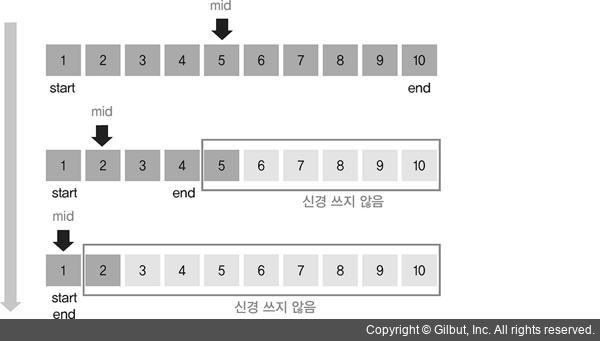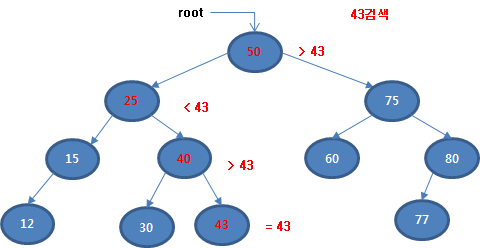이진 탐색 트리 (Binary Search Tree)
이진 탐색 알고리즘
- 정렬된 데이터로 된 리스트(배열이나 연결 리스트)가 인수로 들어왔을 때,
요소 중에 찾고자 하는 데이터가 있는지 알아보는 알고리즘

딕셔너리의 내부 구현
- 딕셔너리는 <key, item>의 쌍으로 된 집합
- 내부적으로 BST, 해시 테이블 두 가지 자료 구조로 구현 가능
- C++의 map은 BST의 변형인 균형 이진 트리, 그 중에서도 레드 블랙 트리를 이용해서 구현
- 자바에서는 HashMap과 TreeMap을 모두 유저 프로그래머가 내부 구현을 선택할 수 있도록 함
- 자바는 레드 블랙 트리를 사용하여 구현함
이진 탐색 트리
- 검색 효율을 높이기 위해 만든 이진 트리
- 노드에 데이터를 직접 저장하지 않는다
- 데이터에 대한 참조만 저장
- 데이터의 참조를 저장하고 있는 노드를 나타내는 키가 중요
- 키만 빠르게 검색 할 수 있다면 데이터는 참조를 이용해서 바로 접근 할 수 있다
- 이진 탐색 트리의 정의
- 모든 키는 유일합니다.
- 어떤 노드를 특정했을 때 이 노드의 키 값은 왼쪽 서브 트리의 그 어떤 키보다 큽니다.
- 어떤 노드를 특정했을 때 이 노드의 키 값은 오른쪽 서브 트리의 그 어떤 키 값보다 작습니다.
- (재귀적 정의) 노드의 서브 트리도 이진 탐색 트리입니다.

이진 탐색 트리의 구현
class TreeNode:
def __init__(self, key):
self.__key=key
self.__left=None
self.__right=None
self.__parent=None
def __del__(self):
print('key {} is deleted'.format(self.__key))
@property
def key(self):
return self.__key
@key.setter
def key(self, key):
self.__key=key
@property
def left(self):
return self.__left
@left.setter
def left(self, left):
self.__left=left
@property
def right(self):
return self.__right
@right.setter
def right(self, right):
self.__right=right
@property
def parent(self):
return self.__parent
@parent.setter
def parent(self, p):
self.__parent=p
class BST:
def __init__(self):
self.root=None
def get_root(self):
return self.root
def preorder_traverse(self, cur, func):
if not cur:
return
func(cur)
self.preorder_traverse(cur.left, func)
self.preorder_traverse(cur.right, func)
# key가 정렬된 상태로 출력
def inorder_traverse(self, cur, func):
if not cur:
return
self.inorder_traverse(cur.left, func)
func(cur)
self.inorder_traverse(cur.right, func)
# 편의 함수
# cur의 왼쪽 자식을 left로 만든다.
def __make_left(self, cur, left):
cur.left=left
if left:
left.parent=cur
# 편의 함수
# cur의 오른쪽 자식을 right로 만든다.
def __make_right(self, cur, right):
cur.right=right
if right:
right.parent=cur
def insert(self, key):
new_node=TreeNode(key)
cur=self.root
if not cur:
self.root=new_node
return
while True:
parent=cur
if key < cur.key:
cur=cur.left
if not cur:
self.__make_left(parent, new_node)
return
else:
cur=cur.right
if not cur:
self.__make_right(parent, new_node)
return
def search(self, target):
cur=self.root
while cur:
if cur.key==target:
return cur
elif cur.key > target:
cur=cur.left
elif cur.key < target:
cur=cur.right
return cur
def __delete_recursion(self, cur, target):
if not cur:
return None
elif target < cur.key:
new_left=self.__delete_recursion(cur.left, target)
self.__make_left(cur, new_left)
elif target > cur.key:
new_right=self.__delete_recursion(cur.right, target)
self.__make_right(cur, new_right)
else:
if not cur.left and not cur.right:
cur=None
elif not cur.right:
cur=cur.left
elif not cur.left:
cur=cur.right
else:
replace=cur.left
replace=self.max(replace)
cur.key, replace.key=replace.key, cur.key
new_left=self.__delete_recursion(cur.left, replace.key)
self.__make_left(cur, new_left)
return cur
def delete(self, target):
new_root=self.__delete_recursion(self.root, target)
self.root=new_root
def min(self, cur):
while cur.left != None:
cur=cur.left
return cur
def max(self, cur):
while cur.right != None:
cur=cur.right
return cur
def prev(self, cur):
# 왼쪽 자식이 있다면
# 왼쪽 자식에서 가장 큰 노드
if cur.left:
return self.max(cur.left)
# 부모 노드를 받아온다
parent = cur.parent
# 현재 노드가 부모 노드의 왼쪽 자식이면
while parent and cur==parent.left:
cur=parent
parent=parent.parent
return parent
def next(self, cur):
# 오른쪽 자식이 있다면
# 오른쪽 자식에서 가장 작은 노드
if cur.right:
return self.min(cur.right)
# 부모 노드를 받아온다
parent = cur.parent
# 현재 노드가 부모 노드의 오른쪽 자식이면
# 루트에 도달하거나
# 현재 노드가 부모 노드의 왼쪽 자식이 될 때까지
# 계속 부모 노드로 이동
while parent and cur==parent.right:
cur=parent
parent=parent.parent
return parent
if __name__=="__main__":
print('*'*100)
bst=BST()
bst.insert(6)
bst.insert(3)
bst.insert(2)
bst.insert(4)
bst.insert(5)
bst.insert(8)
bst.insert(10)
bst.insert(9)
bst.insert(11)
f=lambda x: print(x.key, end=' ')
#bst.preorder_traverse(bst.get_root(), f)
bst.inorder_traverse(bst.get_root(), f)
print()
searched_node = bst.search(8)
if searched_node:
print(f'searched key : {searched_node.key}')
prev_node = bst.prev(searched_node)
if prev_node:
print(f'prev key : {prev_node.key}')
else:
print(f'this is the first key of the BST')
next_node = bst.next(searched_node)
if next_node:
print(f'next key : {next_node.key}')
else:
print(f'this is the last key of the BST')
else:
print('there is no such key')
print()
print (f'MIN(bst) : {bst.min(bst.get_root()).key}')
print(f'MAX(bst) : {bst.max(bst.get_root()).key}')
#bst.delete(9)
#bst.delete(8)
bst.delete(6)
#print(bst.delete(15))
bst.preorder_traverse(bst.get_root(), f)
# bst.inorder_traverse(bst.get_root(), f)
print()
print('*'*100)
이진 탐색 트리의 단점
- 정렬된 데이터가 삽입되면 각 레벨마다 노드가 하나씩만 있는 편형 이진 트리가 됨
- 연결 리스트와 같음
- 삽입, 삭제, 탐색 모두 O(n)
=> 이를 보완한 이진 탐색 트리가 레드 블랙 트리가 포함되는 균형 이진 트리
